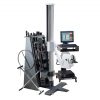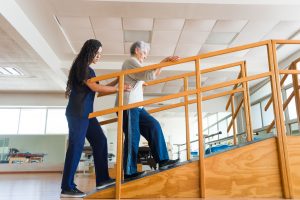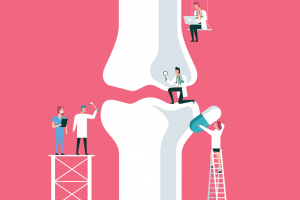
Joint Protection for Aging Clients
Treatment GuidelinesJoint protection helps prevent deformities, slows the progression of joint damage, and can help post-surgery healing. Let’s explore exercises, mechanics, modifications, adaptive equipment, and orthotics for joint protection.
Joint protection is often overlooked in the discussion about health and wellness for our aging clients. However, joint protection is important to prevent joint deformities as well as to slow the progression of joint damage for clients that are living with degenerative diagnoses such as arthritis, spondylosis and Ehlers Danlos. Clients with acute issues such as gout or post joint surgeries also benefit from joint protection to allow for healing.
If you work with elderly clients, they could likely benefit from some of these techniques. Let’s explore exercises, mechanics, modifications, adaptive equipment, and orthotics for joint protection.
Exercise and Joint Protection
Clients may be hesitant to engage in exercise when concerned about inflamed, unstable or healing joints. However, after careful considerations of contraindications, the proper exercise can support joint healing and wellness. Low impact exercises such as swimming, walking and yoga help to strengthen the muscles around the joints, providing additional support.
For clients who have pain or where full range of motion in contraindicated, isometric exercises may be safer. Isometric exercises will increase muscle strength without moving the joint through the full range of motion. The findings of a study published in the peer reviewed journal BMC Sports Science, Medicine and Rehabilitation suggested that isometric exercises might also be a beneficial treatment for improving pain and disability caused by cervical spondylosis1.
Body Mechanics
Proper body mechanics are not only important for protecting joints but they are important for preventing injury to the muscles to support the already compromised joints. Three meaningful ways to initiate proper body mechanics are:
- Push instead of pulling an item
- Lift with the knees
- Carry items close to the body
Environmental Modifications
A client-centered approach to joint protection is modifying the environment to suit their needs and abilities. Here are a few examples of environmental modifications.
- Place frequently used and heavy items where they can be retrieved from waist level.
- To reduce neck strain, place items such as the television, computer screens or books at eye level to promote neutral positioning of the neck. This is an important modification for a client that has spondylosis.
- Add a fence to the yard for the dog instead of having a leash the control to reduce joints being pulled.
- Use an ergonomic set up for the office.
Task Modifications
According to the CDC, the hand is the second most prevalent site of osteoarthritis2. Suggesting that our clients rest their hands is not always a reasonable request. Just like us, they need their hands for all types of daily activities. Instead of avoiding activity, task modifications allow clients to engage in functional tasks with less strain. Task modifications allow clients to participate in desired activities while protecting their joints. Here are a few easy ways to alter tasks:
- Use a talk to text feature on the computer or phone and a voice command on the TV remote. This will decrease repetitive finger motions, sustained controlled finger isolation, and improper wrist positioning.
- Use a stylus to push small buttons.
- Complete tasks that require more effort earlier in the day and include rest breaks during tasks that require repetitive motions. This will allow the joints to rest. However, it is important to note that rest breaks should be taken before the point of fatigue to prevent inflammation and damage to the joints.
- Divide a heavy load into smaller loads.
- Use grocery delivery, house cleaning and yard maintenance services if this is financially feasible.
Adaptive Equipment
Despite the age and physical challenges of our clients, many lead full lives that include dinners with friends, attending community events, and making meals for loved ones. Adaptive equipment can provide assistance with fine motor and self-care activities while reducing the workload for the joints.
- Adaptive pens and pencils for completing work or leisure tasks.
- Enlarged handled eating and cooking utensils for meal prep and meals.
- Long-handled sponges for bathing.
- Enlarged and / or long-handled combs and brushes for grooming.
- Button hooks to close button-up shirts.
- Key grips for maintaining a sufficient grip on keys to use them.
Orthotics
Sometimes the joints need additional reinforcement to keep them stable and prevent deformities. For example, a client living with Ehlers Danlos may benefit from ring splints to stabilize hypermobile finger joints while someone with arthritis may benefit from a ring splint to prevent a swan neck deformity in the finger joints. Joints can also be protected with ankle splints and wrist braces.
Joint protection is an important part of the wellness journey for patients with varying diagnoses. With the proper plan in place, joint pain won’t limit our clients’ ability to engage in everyday activities. Protecting their joints with these strategies will enhance their ability to enjoy their life to the fullest.
Tasha Holmes, MOT, OTR/L, BCP
Tasha Perkins Holmes, MOT, OTR/L, BCP, is an occupational therapist, telehealth expert and freelance healthcare writer. She has created continuing education courses for allied health professionals as well as instructed future healthcare professionals. Writing is a means for her to share her knowledge about healthcare topics that are important to healthcare providers and consumers. Writing also provides a way for her to advocate for equitable access to healthcare and to increase the healthcare literacy of the public. Feel free to reach out on LinkedIn at Upwork.
References:
- Sadeghi, A., Rostami, M., Ameri, S. et al. Effectiveness of isometric exercises on disability and pain of cervical spondylosis: a randomized controlled trial. BMC Sports Sci Med Rehabil 14, 108 (2022). https://doi.org/10.1186/s13102-022-00500-7
- Centers for Disease Control and Prevention. (2011). Osteoarthritis. Retrieved June 20, 2022,from http://www.cdc.gov/arthritis/basics/osteoarthritis.htm





